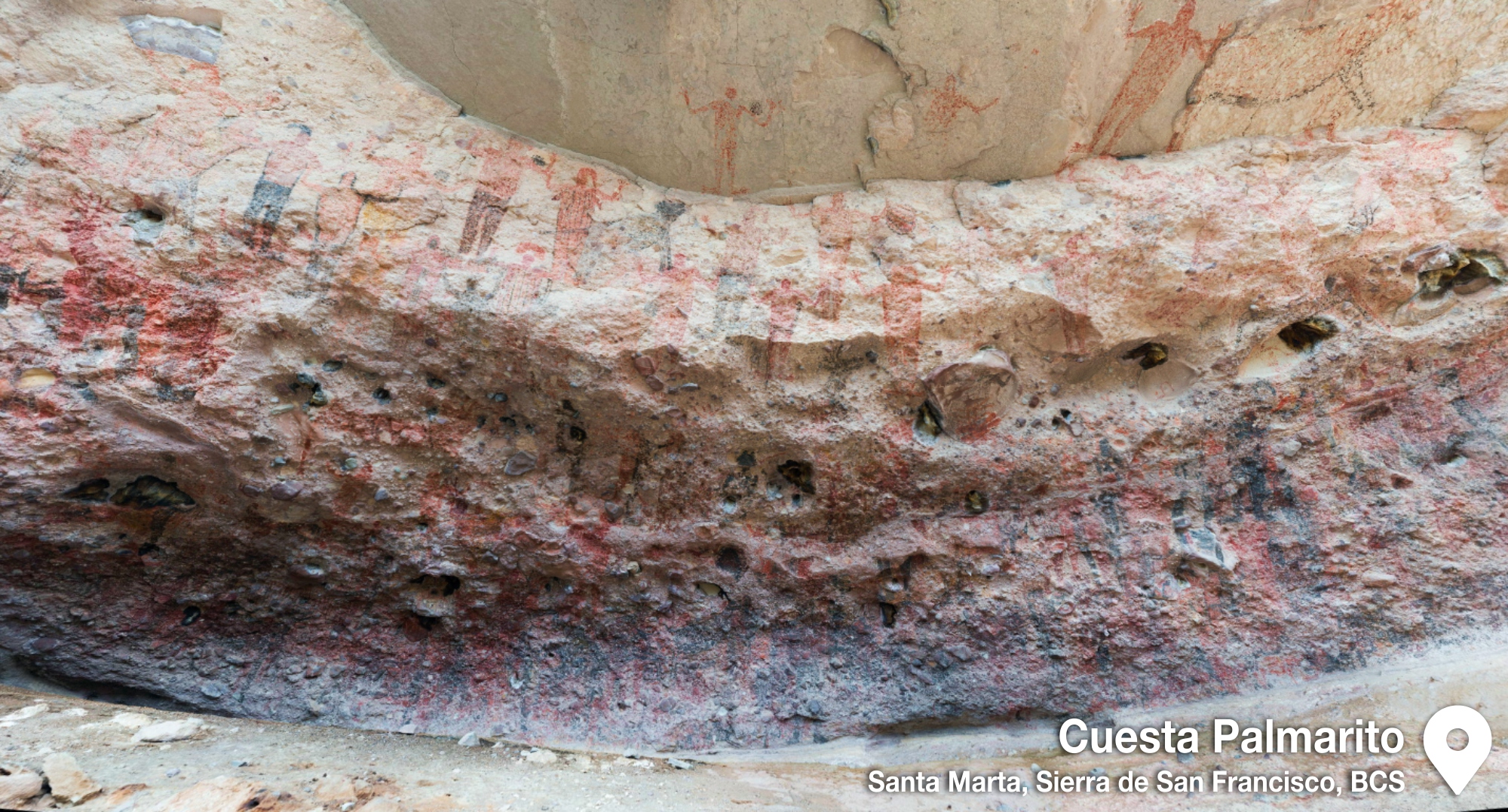Cuesta Palmarito

La cueva Cuesta de Palmarito es uno de los sitios con pinturas rupestres que forma parte del estilo pictórico Sierra de San Francisco y se localiza en una de las vertientes que caen al pequeño valle de Santa Marta, lugar donde se localiza la comunidad del mismo nombre, que es por donde se accede a este sitio. La Cuesta de Palmarito es un sitio de difícil acceso pues se encuentra en lo alto de una pendiente muy pronunciada y las figuras se localizan mayormente en lo alto de la pared rocosa que da forma a esta cueva, la cual es una de las de mayor altura en toda el área. Todo indica que este sitio con pinturas rupestres es uno de los primeros referenciados por los misioneros, principalmente por el padre jesuita José Mariano Rothea, quien se desempeñó como misionero en San Ignacio, que era el establecimiento religioso más cercano a la ranchería indígena que al parecer acampaba precisamente donde ahora se enclava la comunidad de Santa Marta. Este sitio, al igual que muchos otros con pinturas rupestres, ha sido relacionado con la existencia de varios mitos indígenas que dan cuenta del comienzo de la vida y la creación de los primeros seres humanos en el mundo antiguo peninsular. Por otra parte, se ha considerado que en general las pinturas rupestres pueden estar relacionadas con la representación de los muertos, la “posesión del espíritu, el trance” y un “vuelo” que se lograría por diferentes medios, pero destacadamente con la ingesta de plantas alucinógenas nativas que crecen en los montes peninsulares. El Palmarito, o “cueva de la Cuesta Palmarito,” como también se le denomina, tiene una temporalidad fijada a una figura femenina del orden de los 9,200 años antes del presente, lo cual hace de este lugar el más antiguo con pintura rupestre, más antiguo aún, que una figura fechada de San Borjita, la cual era tenida como la más lejana en el tiempo, con una datación de 7,500 años antes del presente.
The Cuesta de Palmarito cave is one of the sites with cave paintings that is part of the Sierra de San Francisco pictorial style and is located on one of the slopes that fall into the small valley of Santa Marta, where the community of the same name is located, which is where this site is accessed. The Cuesta de Palmarito is a site of difficult access because it is at the top of a very steep slope and the figures are mostly located at the top of the rock wall that shapes this cave, which is one of the highest throughout the area. Everything indicates that this site with cave paintings is one of the first referenced by the missionaries, mainly by Jesuit Father José Mariano Rothea, who served as a missionary in San Ignacio, which was the closest religious establishment to the indigenous ranchería that apparently He camped precisely where the community of Santa Marta now sits. This site, like many others with cave paintings, has been related to the existence of several indigenous myths that account for the beginning of life and the creation of the first human beings in the ancient peninsular world. On the other hand, it has been considered that in general the cave paintings may be related to the representation of the dead, the "possession of the spirit, the trance" and a "flight" that would be achieved by different means, but notably with the intake of native hallucinogenic plants that grow in the peninsular mountains. The Palmarito, or "cave of the Cuesta Palmarito," as it is also called, has a temporality fixed to a female figure of the order of 9,200 years before the present, which makes this place the oldest with cave painting, more still old, that a dated figure of San Borjita, which was considered the furthest in time, dating 7,500 years before the present.
Detalles
Lugar: Mulegé, Mulegé
Dirección: Camino a San Francisco de la Sierra Km 36, Mulegé, Baja California Sur
Página web: Sendarupestre.cultura-bcs.gob.mx

